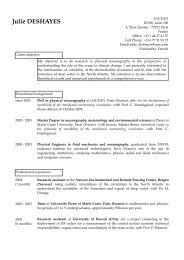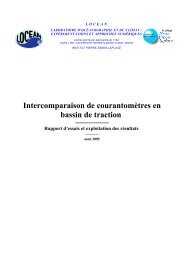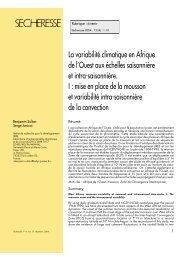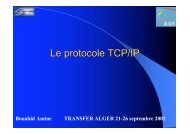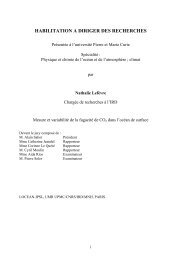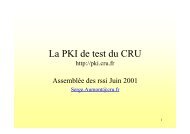PISCES biogeochemical model - NEMO
PISCES biogeochemical model - NEMO
PISCES biogeochemical model - NEMO
You also want an ePaper? Increase the reach of your titles
YUMPU automatically turns print PDFs into web optimized ePapers that Google loves.
The parametrization for the grazing on multiple ressources slightly differs from the one<br />
adopted for microzooplankton (compare with equation 14):<br />
g meso (N) = g meso p meso<br />
N N<br />
KG<br />
meso + ∑ (p meso<br />
I I)<br />
I<br />
p meso<br />
N =<br />
γ N N<br />
∑<br />
(γ I I)<br />
I<br />
This parameterization implies that mesozooplankton preferentially grazes on the more abundant<br />
prey. This formulation stabilizes the <strong>model</strong>. This is the reason it has been adopted for the last<br />
trophic level of <strong>PISCES</strong>.<br />
There is one exception to this parameterization of grazing. Grazing on big particles (POC b )<br />
differs from grazing on the other four types of prey. The reason is that it represents flux feeding<br />
rather than “conventional” grazing. Flux feeding does not depend on the concentration of the<br />
prey but on its flux:<br />
g meso (P OC b ) = gF meso<br />
F w P OC P OC<br />
b b<br />
(17)<br />
KP F OC F<br />
b<br />
+ P OC b<br />
In this equation, there is a michaelis-menten function to avoid an infinite increase of grazing<br />
with particles. Thus, for small concentrations of POC b , flux feeding increases linearly with<br />
the flux and then smoothly saturates when concentrations become high. The choice for the<br />
parameters in this function is rather arbitrary and difficult.<br />
In the equation for mesozooplankton, the term with a square dependancy to mesozooplankton<br />
does not depict aggregation but grazing by the higher, non-resolved trophic levels. This<br />
term depends on temperature with a Q 10 of 1.9, exactly like grazing and respiration/mortality.<br />
3.7 Equation for DOC<br />
(16)<br />
∂DOC<br />
∂t<br />
= δ nano µ nano P + δ diat µ diat D + (1 − ɛ micro )r micro Z<br />
K micro + Z Z<br />
+(1 − ɛ meso )r meso M<br />
K meso + M M + (1 − σmicro − e micro )<br />
(1 − γ micro )(g micro (P ) + g micro (D) + g micro (P OC s ))Z<br />
+(1 − σ meso − e meso )(1 − γ meso )(g meso (P ) + g meso (D)<br />
+g meso (Z) + g meso (P OC s ) + g meso (P OC b ))M + λ ⋆ P OCP OC s<br />
−λ ⋆ OCs<br />
DOC DOC − ΦDOC→P agg − Φ DOC→P OC b<br />
agg (18)<br />
where the remineralization rate of DOC is parameterized as follows:<br />
λ ⋆ DOC = λ DOCL bac<br />
120m<br />
lim0.7(Z + M) min(1, )<br />
z<br />
L bac<br />
Lim = DOC<br />
Lnano lim<br />
KDOC bac + DOC<br />
In the previous equation, 0.7(Z+M) is a proxy for the bacterial concentration. This relationship<br />
has been constructed from a version of <strong>PISCES</strong> that includes an explicite description<br />
of the bacterial biomass. Above 120m, this proxy is kept constant and set to its value at 120m.<br />
The terms Φ denote aggragation processes and are described hereafter (see Equation 21).<br />
7<br />
(19)





